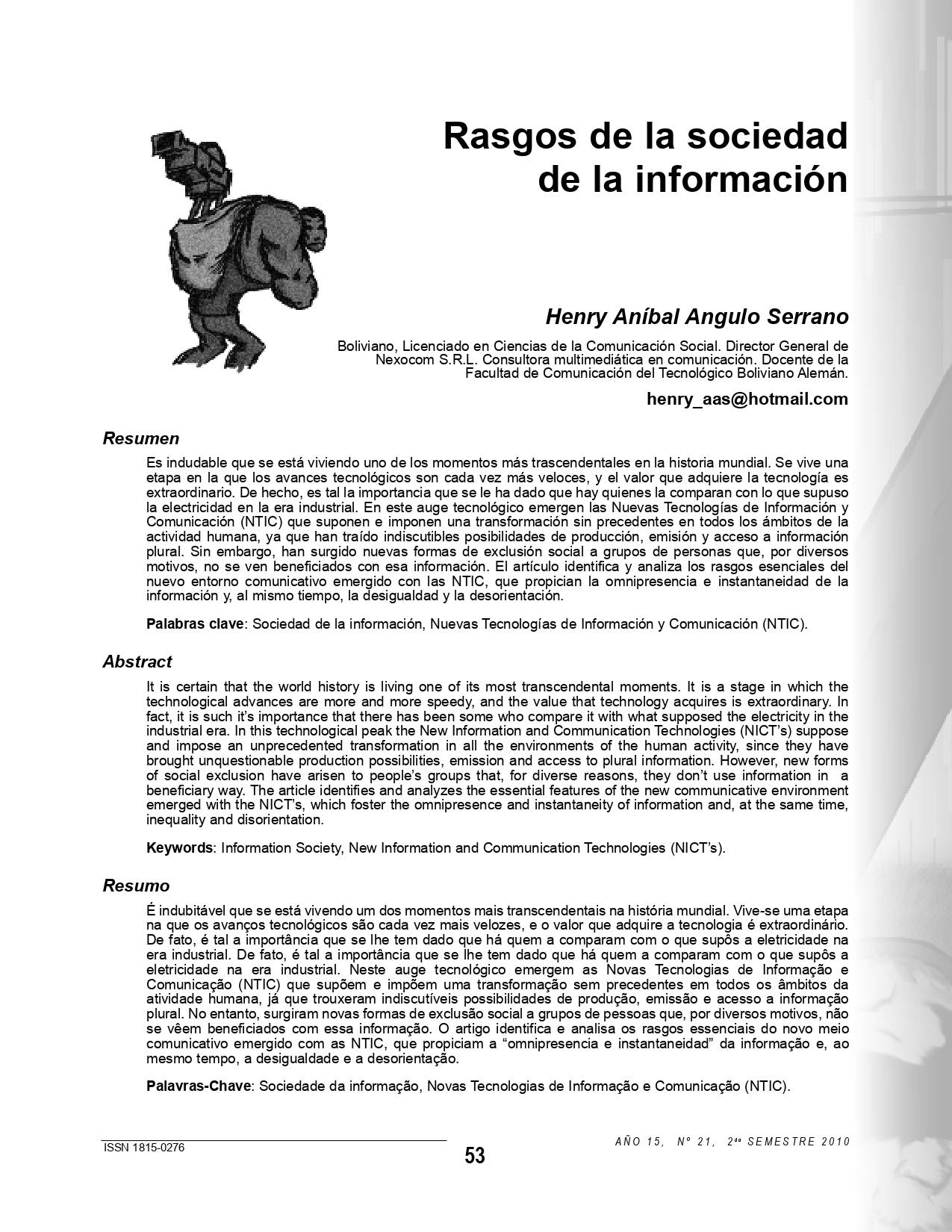Characteristics of the information society
Keywords:
Information Society, New Information and Communication Technologies (NICT's)Abstract
It is certain that the world history is living one of its most transcendental moments. It is a stage in which the technological advances are more and more speedy, and the value that technology acquires is extraordinary. In fact, it is such it's importance that there has been some who compare it with what supposed the electricity in the industrial era. In this technological peak the New Information and Communication Technologies (NICT's) suppose and impose an unprecedented transformation in all the environments of the human activity, since they have brought unquestionable production possibilities, emission and access to plural information. However, new forms of social exclusión have arisen to people's groups that, for diverse reasons, they don't use information in a beneficiary way. The article identifies and analyzes the essential features of the new communicative environment emerged with the NICT's, which foster the omnipresence and instantaneity of information and, at the same time, inequality and disorientation.
References
ANDRADE, Francisco. (2009) “El tiempo, un recurso crítico”. Boletín Tress. [Web].
Disponible en: <http://www.tress.com.mx/boletin/ abril2003/ tiempo.htm>. [09/02/09].
ANDREW, Michael. (2009) “La nueva sociedad. El salto de una a otra”. [DVD-ROM]. Asunción, Gansel.
CASTELLS, Manuel.(1999) La era de la información. Economía, sociedad y cultura. La sociedad red Vol. 1. Madrid, Alianza.
CASTELLS, Manuel. (2001) La galaxia Internet. Reflexiones sobre Internet, empresa y sociedad. Madrid, Plaza & Janés.
CIA WORLD FACTBOOK. (2007) “Usos de Internet. Datos mundiales”. Noticiasdot. [Web]. Disponible en: <http://www2.noticiasdot.com/publicaciones/2007/005/104/noticias/internetnumeros/internetnumeros-11.htm>. [21/11/07].
CMSI. (2004) “Declaración de principios. Construir la sociedad de la información”. International Telecommunications Union. [Web]. Disponible en: <http://www.itu.int/wsis/docs/geneva/off icial /dop-es.htm>. [15/05/05].
EL MUNDO. (2005) “Adobe compró Macromedia”. Elmundo.es. [Web]. Disponible en: <http://www.elmundo.es/navegante/2005/04/18/empresas/ 1113812691.htm>. [21/06/05].
EL MUNDO. (2006) “Google acuerda la compra de YouTube por más de 1.300 millones de euros”. Elmundo.es. [Web]. Disponible en: < h t t p : / /www. e lmu n d o . e s / n a v e g a n t e/2006/10/09/tecnologia/ 1160426206.html>. [11/10/06].
EXENI, José Luís, (2002) “Retos y oportunidades de la sociedad de la información”. Crisbolivia. [Web]. Disponible en: . [03/01/03].
FLORES VIVAR, Jesús; y AGUADO, Guadalupe. (2005) Modelos de negocio en el ciberperiodismo. Madrid, Fragua.
JD POWER FORRESTER RESEARCH. (2007) “Usos de Internet”. Noticiasdot. [Web]. Disponible en: . [01/02/08].
KAPUŚCIŃSKI, Ryszard. (2003) Los cinco sentidos del periodista. Estar, ver, oír, compartir, pensar. México DF, Fundación para un Nuevo Periodismo Iberoamericano.
LESO, Robert. (2005) Un nuevo periodismo para una nueva sociedad. México DF, Gramal.
MARTINI, Stella. (2000) Periodismo, noticia y noticiabilidad. Buenos Aires, Norma.
MINIWATTS MARKETING GROUP. (2008a) “Evolución histórica del número de usuarios de Internet”. Éxito exportador. [Web]. Disponible en: <http://www.noticiasdot.com/publicaciones/2 0 0 8 5 / 0 9 0 5 / 1 0 0 9 / n o t i c i a s / i n t e r n e t -numeros/internet-numeros-03.htm>. [17/06/08].
– (2008b) “Estadísticas mundiales de Internet”. Éxito exportador. [Web]. Disponible en: . [06/06/08].
NARVÁEZ, Ancízar. (2004) “La sociedad de la información o la utopía económica y cultural del neoliberalismo”. 70 años de periodismo y comunicación en América Latina. [CD-ROM]. Buenos Aires, Universidad Nacional de la Plata, ALAIC y otros.
PALACIOS, Adrián. (2009) “Multimedia”. [CDROM]. Boston, HG Professional.
PORTER, Thomas. (2009) “Multimedia, interactividad e hipermedialidad”. [CD-ROM]. Barcelona, Technology Education.
REIG, Ramón (2000). Periodismo de investigación. Realidades, falacias y deseos. Madrid, Libertarias-Prodhufi.
– (2004) Dioses y diablos mediáticos. Barcelona, Urano.
SANDOVAL, Teresa. (2009) “El periodista digital. Precariedad laboral y nuevas oportunidades”. Telos. [Web]. Disponible en: . [18/05/09].
STEVENS, Joseph. (2009) “Nuevas tecnologías”. [DVD-ROM]. Barcelona, Technology Education.
TORRICO, Erick. (2003) Conceptos y hechos de la sociedad informacional. Miradas desde y sobre Bolivia. La Paz, Universidad Andina Simón Bolívar.
TREJO, Raúl (2003) Apreciar y estudiar a los medios. Quimeras e insuficiencias en la era de la globalidad. En PASQUALI, Antonio y otros. Ciencias de la Comunicación y Sociedad. Un diálogo para la era digital. Santa Cruz, Universidad Privada de Santa Cruz de la Sierra.
TREJO, Raúl. (2005) “La sociedad de la información”. Revista interamericana de ciencia, tecnología, sociedad e innovación. [Web]. Disponible en: <http://www.campusoei.org/revistactsi/ numero4/trejo.htm>. [18/11/05].
TULLOCH, Christopher; y PALACIO, Gorka. (2003) Nuevas tecnologías e información audiovisual digital. Bilbao, UPV-EHU.
WOLTON, Dominique. (2000) Internet ¿y después? Barcelona, Gedisa.

Downloads
Published
How to Cite
Issue
Section
License
Copyright (c) 2025 Revista Punto Cero

This work is licensed under a Creative Commons Attribution-NonCommercial 4.0 International License.




